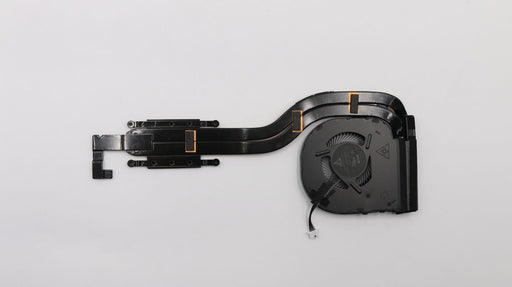Cooling
Computer cooling is required to remove the waste heat produced by computer components, to keep components within permissible operating temperature limits. Components that are susceptible to temporary malfunction or permanent failure if overheated include integrated circuits such as Central processing units (CPUs), chipset, graphics cards, and hard disk drives.
Components are often designed to generate as little heat as possible, and computers and operating systems may be designed to reduce power consumption and consequent heating according to workload, but more heat may still be produced than can be removed without attention to cooling. Use of heatsinks cooled by airflow reduces the temperature rise produced by a given amount of heat. Attention to patterns of airflow can prevent the development of hotspots. Computer fans are widely used along with heatsinks to reduce temperature by actively exhausting hot air. There are also more exotic cooling techniques, such as liquid cooling. All modern day processors are designed to cut out or reduce their voltage or clock speed if the internal temperature of the processor exceeds a specified limit.
Cooling may be designed to reduce the ambient temperature within the case of a computer, such as by exhausting hot air, or to cool a single component or small area (spot cooling). Components commonly individually cooled include the CPU, Graphics processing unit (GPU) and the northbridge.
Components are often designed to generate as little heat as possible, and computers and operating systems may be designed to reduce power consumption and consequent heating according to workload, but more heat may still be produced than can be removed without attention to cooling. Use of heatsinks cooled by airflow reduces the temperature rise produced by a given amount of heat. Attention to patterns of airflow can prevent the development of hotspots. Computer fans are widely used along with heatsinks to reduce temperature by actively exhausting hot air. There are also more exotic cooling techniques, such as liquid cooling. All modern day processors are designed to cut out or reduce their voltage or clock speed if the internal temperature of the processor exceeds a specified limit.
Cooling may be designed to reduce the ambient temperature within the case of a computer, such as by exhausting hot air, or to cool a single component or small area (spot cooling). Components commonly individually cooled include the CPU, Graphics processing unit (GPU) and the northbridge.
Filters
- Aerocool (0)
- Akasa (0)
- Alpenföhn (0)
- Alphacool (0)
- AMD (0)
- aqua computer (0)
- ARCTIC (0)
- Arctic Cooling (0)
- Asrock (0)
- Asus (0)
- ASUS (0)
- AXAGON (0)
- BE (0)
- BE QUIET! (0)
- CISCO (0)
- Cooler Master (0)
- Corsair (0)
- Cryorig (0)
- DEEPCOOL (0)
- Dell (0)
- DELL (0)
- EATON (0)
- EK Water Blocks (0)
- ENDORFY (0)
- Endorfy (0)
- ENERMAX (0)
- EXTREME (0)
- FRACTAL DESIGN (0)
- GEMBIRD (0)
- Gigabyte (0)
- GRIZZLY (0)
- Hewlett (0)
- Hewlett Packard Enterprise (0)
- HEWLETT PACKARD ENTERPRISE (0)
- HP (0)
- HPE (0)
- Intel (0)
- Jonsbo (0)
- KOLINK (0)
- KRUX (0)
- Lanview (0)
- LC-Power (0)
- Lenovo (1)
- LIAN LI (0)
- Montech (0)
- MSI (0)
- NATEC (0)
- No name (0)
- noctua (0)
- NZXT (0)
- OWC (0)
- Phanteks (0)
- QNAP (0)
- Raijintek (0)
- Razer (0)
- SAVIO (0)
- Scythe (0)
- Sea Sonic (0)
- Silentium PC (0)
- SilentiumPC (0)
- SilverStone (0)
- STARTECH (0)
- StarTech (0)
- StarTech.com (0)
- Super Micro (0)
- Supermicro (0)
- Synology (0)
- thermal grizzly (0)
- Thermaltake (0)
- VLK (0)
- White Shark (0)
- XILENCE (0)
- 0037332268525 (0)
- 0065030782739 (0)
- 0065030783446 (0)
- 0065030786355 (0)
- 0065030786362 (0)
- 065030787314 (0)
- 0065030788847 (0)
- 0065030790130 (0)
- 0065030820387 (0)
- 0065030826631 (0)
- 0065030845311 (0)
- 0065030845335 (0)
- 0065030845380 (0)
- 0190017360782 (0)
- 0190017503851 (0)
- 0190017503943 (0)
- 0190017583761 (0)
- 0644728042203 (0)
- 0672042423835 (0)
- 0840006600848 (0)
- 0840006605577 (0)
- 0840006605584 (0)
- 0840006611677 (0)
- 0840006611691 (0)
- 0840006619499 (0)
- 0840006619512 (0)
- 0840006622918 (0)
- 0840006623700 (0)
- 0840006623717 (0)
- 0840006623823 (0)
- 0840006628019 (0)
- 0840006628613 (0)
- 0840006628620 (0)
- 0840006636366 (0)
- 0840006636373 (0)
- 0840006636649 (0)
- 0840006636663 (0)
- 0840006637769 (0)
- 0840006637776 (0)
- 0840006637783 (0)
- 0840006637790 (0)
- 0840006644323 (0)
- 0840006644330 (0)
- 0840006644705 (0)
- 0840006644712 (0)
- 0840006646198 (0)
- 0840006648109 (0)
- 0840006648116 (0)
- 0840006648123 (0)
- 0840006650812 (0)
- 0840006650829 (0)
- 4260052184226 (0)
- 4260052187319 (0)
- 4711081134732 (0)
- 4711081316978 (0)
- 4711081886495 (0)
- 4711081927617 (0)
- 4711081927945 (0)
- 4711081943099 (0)
- 4711081943273 (0)
- 4711387050507 (0)
- 4716123314875 (0)
- 4716123315582 (0)
- 4716123315698 (0)
- 4718017058155 (0)
- 4719072864088 (0)
- 4719512110157 (0)
- 4719512111536 (0)
- 4719512132685 (0)
- 4719512134092 (0)
- 4719512137710 (0)
- 4719512143797 (0)
- 4895213702461 (0)
- 4895213703444 (0)
- 5056547200200 (0)
- 5397184115138 (0)
- 5903018665825 (0)
- 5903018665832 (0)
- 5903018665849 (0)
- 5903018665856 (0)
- 5903018665863 (0)
- 5903018665870 (0)
- 5903018665887 (0)
- 5903018665894 (0)
- 5903018665900 (0)
- 6933412727774 (0)
- 6933412727798 (0)
- 6933412727828 (0)
- 6933412727897 (0)
- 6933412727972 (0)
- 6933412728252 (0)
- 9010018000054 (0)
- 9010018000108 (0)
- 9010018000115 (0)
- 9010018000191 (0)
- 9010018000207 (0)
- 9010018000238 (0)
- 9010018000269 (0)
- 9010018000337 (0)
- 9010018000450 (0)
- 712-000052 (2)
- 21839 (1)
- 21840 (1)
- 21841 (1)
- 1318757 (1)
- 1318760 (1)
- 1447547 (1)
- 1679726 (1)
- 1839183 (1)
- 1866859 (1)
- 1866862 (1)
- 1866863 (1)
- 1876956 (1)
- 2112235 (1)
- 2315546 (1)
- 100000576 (1)
- 100015587 (1)
- 100068365 (1)
- 100205244 (1)
- 100267098 (1)
- 100270689 (1)
- 100278252 (1)
- 100279079 (1)
- 100279080 (1)
- 100280579 (1)
- 100280585 (1)
- 100280800 (1)
- 100316897 (1)
- 2218-15F (1)
- 01HW697 (1)
- 01MP403 (1)
- 01YT252 (1)
- 01YU195 (1)
- 02DL974 (1)
- 0R100010 (1)
- 0R100072 (1)
- 1CW2J (1)
- 1GM4N (1)
- 2HW44AA (1)
- 306-7ZW1B41-813 (1)
- 306-7ZW1C41-813 (1)
- 306-7ZW2P31-813 (1)
- 306-7ZW2R11-813 (1)
- 306-7ZW4R14-813 (1)
- 306-7ZW5E27-C24 (1)
- 412-AAMS (2)
- 90DA0030-B09000 (2)
- 90RC0030-M0UAY0 (2)
- 90RC00A0-M0UAY0 (2)
- 90RC00I1-M0UAY0 (2)
- 90RC00I2-M0UAY0 (2)
- 90RC00J1-M0UAY0 (2)
- 90RC00J2-M0UAY0 (2)
- 90RC00L0-M0UAY0 (2)
- ACFRE00077A (3)
- ACFRE00104A (2)
- ACFRE00122A (2)
- BK002 (2)
- BK024 (2)
- CO-9050072-WW (2)
- CW-9060068-WW (2)
- CW-9060069-WW (2)
- CW-9060074-WW (2)
- EY3A005 (3)
- EY3A006 (2)
- EY3A007 (2)
- EY3A008 (2)
- EY3A009 (2)
- EY3A010 (2)
- EY3B001 (2)
- EY3B002 (2)
- EY3B003 (2)
- FAN478 (2)
- FAN1156PWM (2)
- FANCASE (2)
- MLW-D24M-A18PC-RW (2)
- MLW-D36M-A18PZ-RW (2)
- NH-C14S (2)
- NH-D9L (2)
- NH-D12L (2)
- NH-D15S CH.BK (2)
- NH-L9I (2)
- NH-L9I CH.BK (2)
- NH-L12S (2)
- NH-P1 (2)
- NH-U12S REDUX (2)
- NH-U14S TR4-SP3 (2)
- P27095-B21 (2)
- P37042-B21 (3)
- R-AG300-BKNNMN-G (2)
- R-AG400-BKANMC-G-2 (2)
- R-AG620-BKANMN-G-2 (2)
- R-AK400-BKNNMD-G-1 (2)
- R-AK500-BKNNMT-G-1 (2)
- R-AK500S-WHADMN-G (2)
- RC-TR120-W1 (2)
- RR-212TK-18PA-R1 (2)
- RR-S4KK-20PA-R1 (2)
- RR-S4KK-25SN-R1 (2)
- RR-S4WW-20PA-R1 (2)
-
Original price 96.84 - Original price 96.84Original price 96.8496.8496.84 - 96.84Current price 96.84| /
Thermal Fan For Lenovo
LenovoOut of stockThermal fan for Lenovo
Original price 96.84 - Original price 96.84Original price 96.8496.8496.84 - 96.84Current price 96.84| /Sold out
Sort by

